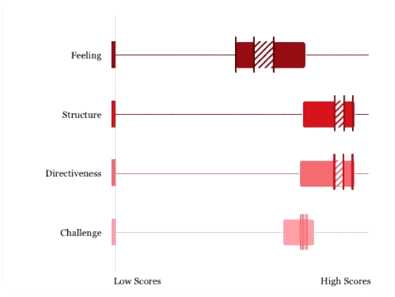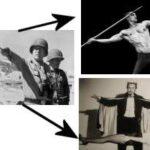Over the past week, leadership has been a recurring theme in my client mentoring sessions. Like many things in life, the universe provides subtle hints leading to answers. Mine occurred when I stumbled upon an enlightening article by Mark Murphy, the founder of Leadership IQ. Intrigued by the concept of leadership, I delved into Mark’s extensive research on the subject.
Leadership Dimensions
Leadership is a complex subject, and there are many different leadership styles, each with its own advantages and disadvantages. Each style can shape a company’s dynamics differently. However, before discussing leadership styles, we must first define four dimensions that can define a leader’s approach and behavior. These dimensions provide a view of how leaders interact with their employees and navigate challenges.
- Challenge – The challenge dimension gauges the leader’s propensity to set high standards and encourage employees to strive for ambitious goals. It reflects the leader’s inclination towards pushing their employees’ boundaries and fostering a culture of continuous improvement. Leaders with a high challenge dimension encourage their employees to strive for excellence, push their limits, and improve their weaknesses.
- Directiveness – The directiveness dimension gauges the extent to which a leader retains final decision-making authority. It reflects the leader’s inclination to tell employees exactly how they want tasks and projects performed. Leaders with a high directiveness dimension often work harder than anyone else, make the consequences of unsatisfactory work clear, and maintain final decision authority with a hands-on and detail-oriented leadership style.
- Structure – The structure dimension gauges the leader’s propensity towards implementing formal processes and organizational frameworks. It reflects the leader’s inclination to emphasize formal procedures, rules, and policies to maintain stability and predictability. Leaders with a high structure dimension seek to create a well-defined, organized work environment where tasks and responsibilities are delineated with a clear chain of command.
- Feeling – The feeling dimension gauges the leader’s propensity to regularly ask employees about their motivators and demotivators. It reflects the leader’s inclination to care about the personal needs of his employees and to create a supportive environment in which employees genuinely like each other and find their work fulfilling. Leaders with a high feeling dimension are empathetic, kind, and focused on maintaining a cohesive and pleasant working atmosphere for their staff.
Understanding a leader’s propensity toward each of these dimensions provides clues to their leadership style. Effective leaders often demonstrate a balanced combination of these dimensions, adapting to different situations and group dynamics. The relationship between challenge, directiveness, structure, and feeling defines the key elements of leadership styles, contributing to a leader’s success in guiding their organization towards shared goals.
Leadership Styles
Now that we have discussed the four dimensions of leadership, let’s look at the four fundamental leadership styles Mark Murphy defines in his book “Leadership Styles: How To Discover And Leverage Yours.”
The Pragmatist

Pragmatists are characterized by their high standards, competitiveness, and their focus on achieving goals. Above all, they are driven to hit targets. Pragmatist leaders exhibit a high challenge dimension, emphasizing ambitious objectives and pushing employees to excel. They also score high on directiveness and structure, providing clear instructions and maintaining a structured approach.
Working for a pragmatist can be challenging but rewarding. However, while offering opportunities for intellectual growth, their leadership style can be intense and demanding, potentially leading to burnout.
Pragmatist leaders are less common, accounting for only 8-12% of all leaders, but they are often found among top-level executives. Examples of pragmatist leaders include Franklin D. Roosevelt, Jeff Bezos, and Steve Jobs, to name a few.
The Idealist

Idealist leaders are high-energy achievers who believe in the positive potential of everyone they lead. Idealist leaders exhibit a high challenge and feeling dimension and prioritize learning, growth, and a collaborative approach, acting as coaches for their employees. Idealists are charismatic, drawing others in with their intuition and idealism.
Working for an idealist offers creative expression and a democratic experience. Idealist leaders foster a positive work environment, encouraging innovation and open-mindedness, and are known for their refined leadership skills.
This leadership style accounts for about 15-20% of all American leaders. Examples of idealist leaders include Sheryl Sandberg (Facebook CEO), Tony Hsieh (Zappos Founder/CEO), and Meg Whitman (HP and eBay CEO).
The Steward

Steward leaders are dependable, loyal, and helpful, providing a stabilizing force for their organization. Steward leaders exhibit a high structure and directiveness dimension, and value rules, processes, and cooperation, emphasizing a structured, directive leadership style. Stewards believe in the strength of the entire organization and move at a pace that allows everyone to keep up.
Working for a steward offers a well-oiled machine with security and cohesion but limits individual glory. Steward leaders are often found in mission-critical areas, relying on their structured and rule-oriented approach to achieve business success.
This leadership style accounts for about 15-20% of all American leaders. Examples of Steward leaders include George Washington, Mother Teresa, and Ginni Rometty (IBM CEO).
The Diplomat

Diplomat leaders prioritize interpersonal harmony and building relationship bonds within the organization. They are kind, social, and adept at resolving conflicts peacefully. Diplomat leaders exhibit a high feeling dimension and focus on maintaining a positive, comfortable work environment, emphasizing deep personal connections with employees.
Working for a diplomat is often enjoyable and social. Diplomat leaders place less emphasis on challenging their employees, and more on leveraging their strengths to success. Traditional measures of employee satisfaction are typically high under diplomat leadership.
This leadership style is the most common and accounts for about 50-60% of all American leaders. Examples of diplomat leaders include Mohandas Gandhi and David Glass (Walmart CEO).
Situational Leadership
Choosing the best leadership style hinges on understanding your organization. Pragmatists propel ambitious teams, idealists nurture creativity, stewards stabilize, and diplomats foster relationship bonds. No one-size-fits-all; adaptability is key.
Servant Leadership
Servant leadership emphasizes serving others and prioritizing their needs, with the primary goal of fostering personal growth and well-being within the organization. Idealists and diplomats are closest to servant leadership, emphasizing personal growth and well-being. Their leadership styles prioritize organizational development. Key attributes of servant leadership are:
- Putting others first
- Empathy
- Listening
- Healing and Support
- Persuasion
- Conceptualization
- Stewardship
Transformational Leadership
Transformational leadership focuses on inspiring, motivating, and empowering followers to achieve their full potential and exceed their own expectations. All leadership styles can be transformational. Pragmatists inspire with audacious goals, idealists foster continuous learning, diplomats empower through personal bonds, and stewards provide stability for organizational success. Key attributes of transformational leadership include:
- Visionary
- Inspirational Motivation
- Intellectual Stimulation
- Individual Considerations
- Employment
- Charisma
- Focus on Values
- Long-Term Perspective
Participative Leadership
Participative leadership (aka democratic leadership) focuses on involving employees in the decision-making process. Rather than making decisions unilaterally, participative leaders seek input and feedback from their employees, encouraging collaboration and shared responsibility. Diplomats excel at participative leadership and their caring nature fosters a collaborative atmosphere, exemplifying democratic leadership by letting employees make decisions. Key features of participative leadership include:
- Inclusive Decision-Making
- Open Communication
- Collaboration
- Shared Responsibility
- Empowerment
- Adaptability
- Feedback
- Enhanced Creativity
Charismatic Leadership
Charismatic leadership focuses on leaders using their personal qualities, charm, and persuasive abilities to inspire and influence their followers. Charismatic leaders often have a magnetic personality, exude confidence, and possess a compelling vision that attracts and motivates others. Idealists excel at charismatic leadership due to their positive and inspiring nature and their ability to create a vision, engage others emotionally, and encourage continuous learning. Key characteristics of charismatic leadership include:
- Charismatic Personality
- Visionary Leadership
- Effective Communication
- Emotional Appeal
- Confidence and Self-Assurance
- Risk-Taking and Unconventionality
- Inspiration and Motivation
- Charismatic Authority
Conclusion
In the ever-evolving leadership landscape, exploring diverse leadership styles becomes not just a strategic choice but a fundamental necessity. Understanding the dimensions of leadership styles, such as structure, challenge, directiveness, and feelings, provides a framework for effective leadership analysis. Each leadership style, whether pragmatic, idealist, steward, or diplomat, brings with it unique strengths and potential challenges. Leaders can navigate the complex landscape of organizational success by recognizing the importance of adapting leadership styles to the context, acknowledging the impact on organizational dynamics, and appreciating the significance of situational leadership.
What leadership styles do you embody most as a leader?












